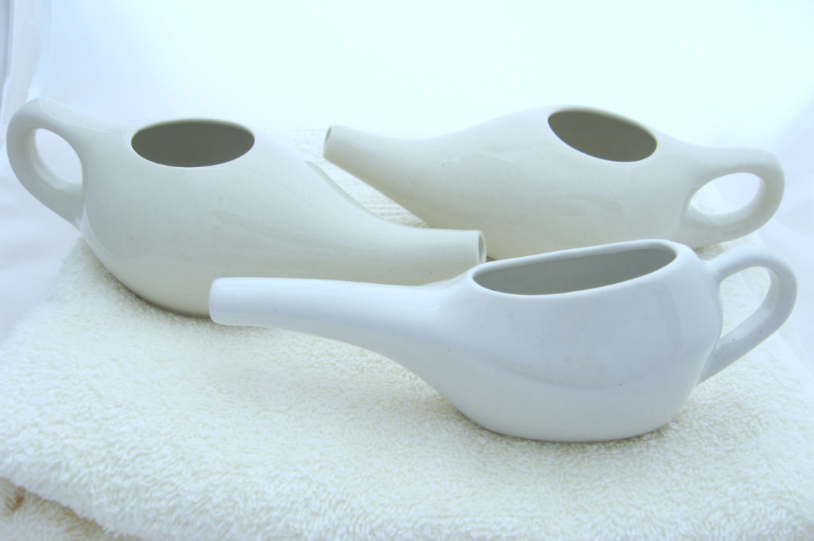How to Use a Neti Pot for Allergy Relief and So Much More
Confluence Daily is your daily news source for women in the know.
Here’s a synopsis of the scenario at my kitchen sink the first time I tried to use a neti pot:
Cough. Choke. Spit.“AAUUGH! WHY IS WATER GOING UP MY NOSE??!!”
“Dammit, It says right here in the instructions that I WILL NOT feel the sensation of water going up my nose! This is totally stupid!” Deep sigh.
“Okay, let’s try one more time.”I tilt my head at a slightly different angle, and…ohhh, I get it, I think as I watch a perfectly arced stream of water pour out of my left nostril.What do you know? This thing really works!
I’d resisted trying out the neti pot for probably years. Even though we sold dozens in my store and customers repeatedly waxed enthusiastic about the benefits, I just couldn’t wrap my brain around the idea of pouring salt water up my nose. All I could think about was the misery I felt as a child when I jumped into the pool forgetting to hold my nose.
But, of course, I did learn how to blow out of my nose while jumping in the pool. Hmmm, maybe should give the neti pot a go. Perhaps, just like the pool, I could master the correct technique.
One day, tired of feeling like my nose was stuffed with lead weights from a nasty cold, I finally brought one home. And guess what? It only took a few false starts to master the correct technique, and in a few more minutes my nasal passage once again felt like an open tunnel rather than the site of a four-vehicle wreck. It worked!
What the heck is a neti pot anyway?
Once considered esoteric and strange, neti pots have soared in popularity on this side of the world in recent years. I even noticed a boxed Walgreen’s version one in my friend’s bathroom the other day. Apparently, they were even featured on Oprah several few years ago, and this might be what brought them to the mainstream gaze. (I don’t know if she did a demo on the show, but if she did I’d love to get a copy of that video.)
These low tech, ancient tools basically flush out your sinuses and nasal passages with a saltwater solution. They can be used occasionally when you are in crisis mode, or on a daily basis to flush out pollutants and to promote easy and comfortable breathing through your nose.
The whole thing works by thinning out the mucus so it can be more easily expelled. Have you ever taken a yoga class when you have a cold? Isn’t it frustrating when you’re told to breathe through your nose and you discover it’s virtually impossible? That’s why yoga devotees love the neti pot. And in fact, it was invented thousands of years ago in ancient India to facilitate yoga and meditation.
It is also used in Ayurveda, the traditional East Indian herbal medicine practice. But the neti pot isn’t just for yogis. This simple technique of nasal irrigation can benefit a number of conditions. Those who suffer from chronic sinus congestion often find that daily use of the neti pot reduces or eliminates the symptoms. The saline rinse speeds healing of inflamed tissues and promotes healthy drainage of the sinuses.
I used to recommend using the neti pot several times a day when you are dealing with a super acute sinus infection. But on experimentation, I’ve discovered that less is more so now I’d say no more than three times per day even if your sinuses feel completely congested.
Allergy sufferers also find relief from respiratory symptoms by irrigating their sinuses with the neti pot. This is an especially helpful tip for folks (like me) who feel like they’re about to pass out when taking over-the-counter allergy medications such as Sudafed. Even some herbal treatments for allergy symptoms cause weird side effects for some individuals—ephedra is a prime example of this.
The neti pot can be a real friend for pregnant women because virtually every natural allergy remedy (except some homeopathics) is contra-indicated during pregnancy. That makes for some serious misery for soon-to-be-Mamas who deal with springtime pollen allergies.
Anyone can use a neti pot, though, it doesn’t matter if you are pregnant, nursing, elderly or three years old (well toddlers might balk a bit I guess.) You saw in the intro that it might take a few tries to master the correct technique – but it’s worth it. This simple process can brighten your day by moistening dry nasal passages, relieving congestion caused by the common cold or simply helping you to breathe more deeply.
Gakked out from breathing in exhaust while walking through a big city? Whip out the neti pot when you get back to your lodgings and all that ick goes away. The neti pot is safe, non-invasive and, unlike other remedies, a one-time investment. Costing anywhere between $10 and $25, a neti pot lasts forever (unless you break it) and all you need to replenish is the salt and the water, two very cheap commodities.
They come in a variety of materials, with ceramic being the most popular. Plastic neti pots are good for traveling but don’t feel as good in your hand or nose. You can find your own neti pot in nearly all health food stores, herb shops, even some drug stores, online. Some people recommend a separate neti pot for each family member, but I think that is a marketing gimmick. We’ve been fine with using just one as long as we’re careful to clean and sterilize it between uses.
How To Use The Neti Pot
Okay it’s true, it takes a couple of minutes of trial and error (as I learned) but once you get the technique down it becomes like second nature to rinse out your sinus passages.
1) Fill the neti pot with warm (not hot and not cold) water. I like to use purified water, so I boil a little and add it to some cold water.
2) Add ¼ teaspoon non-iodized salt. You can buy special salt for your neti pot, and sometimes it comes with a packet. Or just use sea salt, Himalayan, or another high-quality salt. Stir to dissolve.
3) Keep some tissues or a hanky close by and head over to the sink. (You could do this whole thing in the shower too – if you like to irrigate while naked.)
4) Lean over the basin and tilt your head to the side. Insert the spout into one nostril, creating a ‘seal’.
5) Here’s where it gets tricky. You will probably have to adjust your head slightly to get the correct and most comfortable angle. Think about keeping your forehead at an angle about the same level as your chin, or just slightly higher.
6) Raise the neti pot slowly. When you get it right, the water will flow easily from the upper nostril and out the lower nostril. You won’t feel like it’s going up your nose! If you don’t get the angle right, you might find water draining into your mouth – no good! Go for Take 2: adjust the angle of your head to bring the forehead more or less in line with your chin and start over again.
7) You can control of the flow of the saline water. The higher you hold the pot, the faster the flow. Experiment to find the right flow for you by raising the pot slowly while your head is dangling at the correct angle.
8) Drain at least half the pot into one nostril. Most experts recommend using a full pot in each nostril.
9) Ugh – after you’re done with one nostril you’ll want to blow your nose. Grab those tissues, but blow gently! When you’re first trying this out, you might want to take a break halfway through for some gentle nose blowing
10) Repeat all of above on opposite nostril. Weirdly, I’ve found that one side drains more easily than the other. Just continue to experiment with your head angle until you reach that sweet spot and see that lovely arc of water flowing out of the other nostril.
11) Ahh! You can breathe again. You can smell! Proceed to yoga mat and perform intensive nose breathing exercises. Or not.
In any event, smile and breathe in through your newly cleaned sinuses. You might even want to do a happy dance.
More by: Sarah Grace Powers
 Sarah Grace Powers is a certified life coach and EFT Practitioner. She is a ‘dream resuscitator’, helping clients rediscover their passions and reinvent themselves no matter what their age or circumstance. In her previous career she owned and operated an herb shop and has practiced holistic living for over three decades. Find her at sarahgracecoach.com
Sarah Grace Powers is a certified life coach and EFT Practitioner. She is a ‘dream resuscitator’, helping clients rediscover their passions and reinvent themselves no matter what their age or circumstance. In her previous career she owned and operated an herb shop and has practiced holistic living for over three decades. Find her at sarahgracecoach.com





